
Originally appeared here:
Customize small language models on AWS with automotive terminology
Go Here to Read this Fast! Customize small language models on AWS with automotive terminology


Originally appeared here:
Customize small language models on AWS with automotive terminology
Go Here to Read this Fast! Customize small language models on AWS with automotive terminology


Originally appeared here:
Automate emails for task management using Amazon Bedrock Agents, Amazon Bedrock Knowledge Bases, and Amazon Bedrock Guardrails
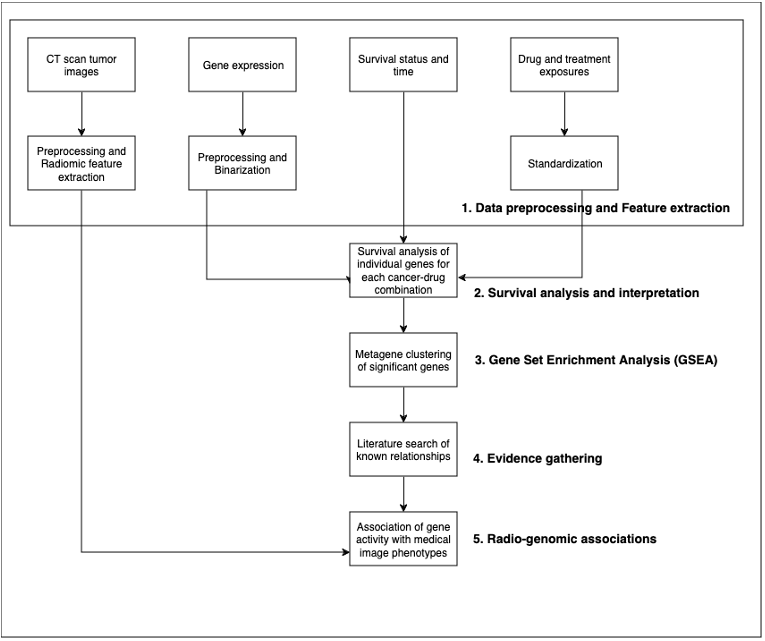

Originally appeared here:
Accelerate analysis and discovery of cancer biomarkers with Amazon Bedrock Agents


Originally appeared here:
Automate building guardrails for Amazon Bedrock using test-driven development


Data Parallelism, Butterfly All-Reduce, Gossiping and More…
Originally appeared here:
Distributed Decentralized Training of Neural Networks: A Primer
Go Here to Read this Fast! Distributed Decentralized Training of Neural Networks: A Primer


Part 4: Extending linear programming optimization to discrete decision variables
Originally appeared here:
Linear programming: Integer Linear Programming with Branch and Bound
Go Here to Read this Fast! Linear programming: Integer Linear Programming with Branch and Bound



Last week, NVIDIA published a fascinating paper (LLaMA-Mesh: Unifying 3D Mesh Generation with Language Models) that allows the generation of 3D mesh objects using natural language.
In simple words, if you can say, “Tell me a joke,” now you can say, “Give me the 3D mesh for a car,” and it can give the output in the OBJ format (more on this shortly) containing the output.
If you’d like to try out few examples, you can do so here — https://huggingface.co/spaces/Zhengyi/LLaMA-Mesh
The most amazing part for me was that it did so without extending the vocabulary or introducing new tokens as is typical for most fine-tuning tasks.
But first, what is a 3D mesh?
A 3D mesh is a digital representation of a 3D object that consists of vertices, edges, and faces.
For example, consider a cube. It has 8 vertices (the corners), 12 edges (the lines connecting the corners), and 6 faces (the square sides). This is a basic 3D mesh representation of a cube. The cube’s vertices (v) define its corners, and the faces (f) describe how those corners connect to form the surfaces.
Here is an example of OBJ file that represents the geometry of the 3D object
# Vertices
v: (0, 0, 0)
v: (1, 0, 0)
v: (1, 1, 0)
v: (0, 1, 0)
v: (0, 0, 1)
v: (1, 0, 1)
v: (1, 1, 1)
v: (0, 1, 1)
# Faces
f 1 2 3 4
f 5 6 7 8
f 1 5 8 4
f 2 6 7 3
f 4 3 7 8
f 1 2 6 5
These numbers are then interpreted by software that will render the final image i.e. 3D cube. (or you can use HuggingFace spaces like this to render the object)
As objects increase in complexity (compared to the simple cube above), they will have thousands or even millions of vertices, edges, and faces to create detailed shapes and textures. Additionally, they will have more dimensions to capture things like texture, direction it is facing, etc.
Realistically speaking, this is what the obj file for an everyday object (a bench) would look like:

As you may have noticed from the image above, LLMs like GPT4o and LLama3.1 are capable, to some extent, of producing the obj file out-of-the-box. However, if you look at the rendered mesh image of the bench in both cases, you can see why fine-tuning is necessary from a quality standpoint.
It is common knowledge that LLMs understand text by converting tokens (like cat) into token ids (like 456). Similarly, in order to work with the standard OBJ format, we must somehow convert the vertices coordinates which are typically decimals into integers.
They use vertex quantization to achieve this in the paper and split a single coordinate into multiple tokens (similar to how a long word like operational would be split into two tokens — oper and ational as per GPT4o tokenizer). As expected, reducing the number of tokens to represent the decimal has a normal precision-cost tradeoff.

To achieve vertex quantization, they scale all three axes in the mesh to the range (0, 64) and quantize the coordinates to the nearest integer, i.e. each of the 3 axes can take a value between 0 and 64 (in this case 39, 19 and 35). Finally, by reading and generating such a format, the LLM is able to work with 3D objects.
LLama-Mesh was created by fine-tuning LLama3.1–8B instruct model using the SFT (Supervised Fine Tuning) method to improve its mesh understanding and generation capabilities.
Since it is an SFT, we need to provide it with input-output examples of Text-3D instructions. Here’s an example:
Input
User: Create a 3D obj file using the following description: a 3D model of a car.
Output
Assistant: <start of mesh> v 0 3 4 v 0 4 6 v 0 3 … f 1 3 2 f 4 3 5 … . <end of mesh>
In addition to generating the 3D mesh, LLama-Mesh is also capable of interpreting the 3d mesh. To this end, its training data also contained several examples for mesh understanding and mesh generation as part of a conversation-style format. Here are a few examples from the dataset




I am already amazed by the capabilities of large language models to generate human-like text, code, and reason with visual content. Adding 3D mesh to this list is just brilliant.
LLMs like LLaMa-Mesh have the potential to revolutionize various industries including gaming, education, and healthcare.
It can be useful for generating realistic assets like characters, environments, and objects directly from text descriptions for video games.
Similarly, it can speed up the product development and ideation process as any company will require a design so they know what to create.
It can also be useful for architectural designs for buildings, machinery, bridges, and other infrastructure projects. Finally, in the edtech space, it can be used for embedding interactive 3D simulations within the training material.
The paper is a straightforward and quick read, and I highly encourage you to do it.
Paper page — https://arxiv.org/pdf/2411.09595
Code — https://github.com/nv-tlabs/LLaMA-Mesh
Nvidia’s Blog — https://research.nvidia.com/labs/toronto-ai/LLaMA-Mesh/
Generate 3D Images with Nvidia’s LLaMa-Mesh was originally published in Towards Data Science on Medium, where people are continuing the conversation by highlighting and responding to this story.
Originally appeared here:
Generate 3D Images with Nvidia’s LLaMa-Mesh
Go Here to Read this Fast! Generate 3D Images with Nvidia’s LLaMa-Mesh
How to read and convert PDFs to Markdown for better RAG results with LLMs
Originally appeared here:
Improved RAG Document Processing With Markdown
Go Here to Read this Fast! Improved RAG Document Processing With Markdown
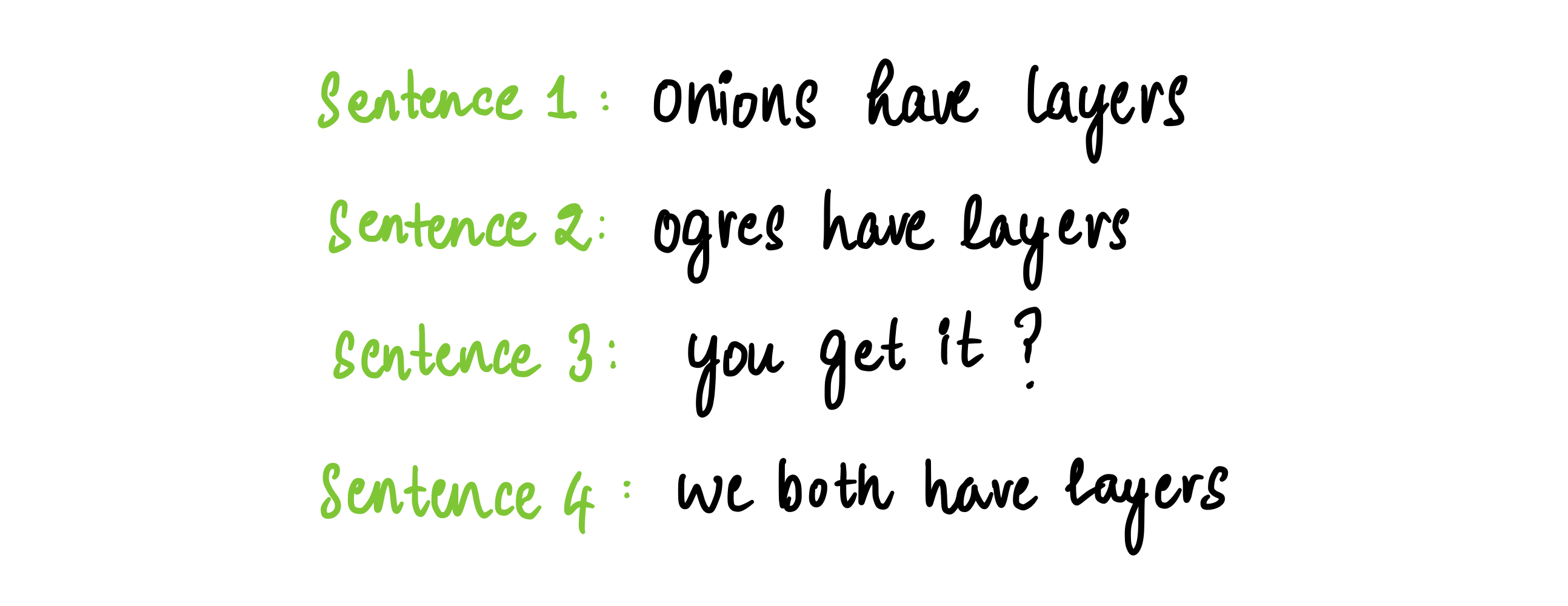
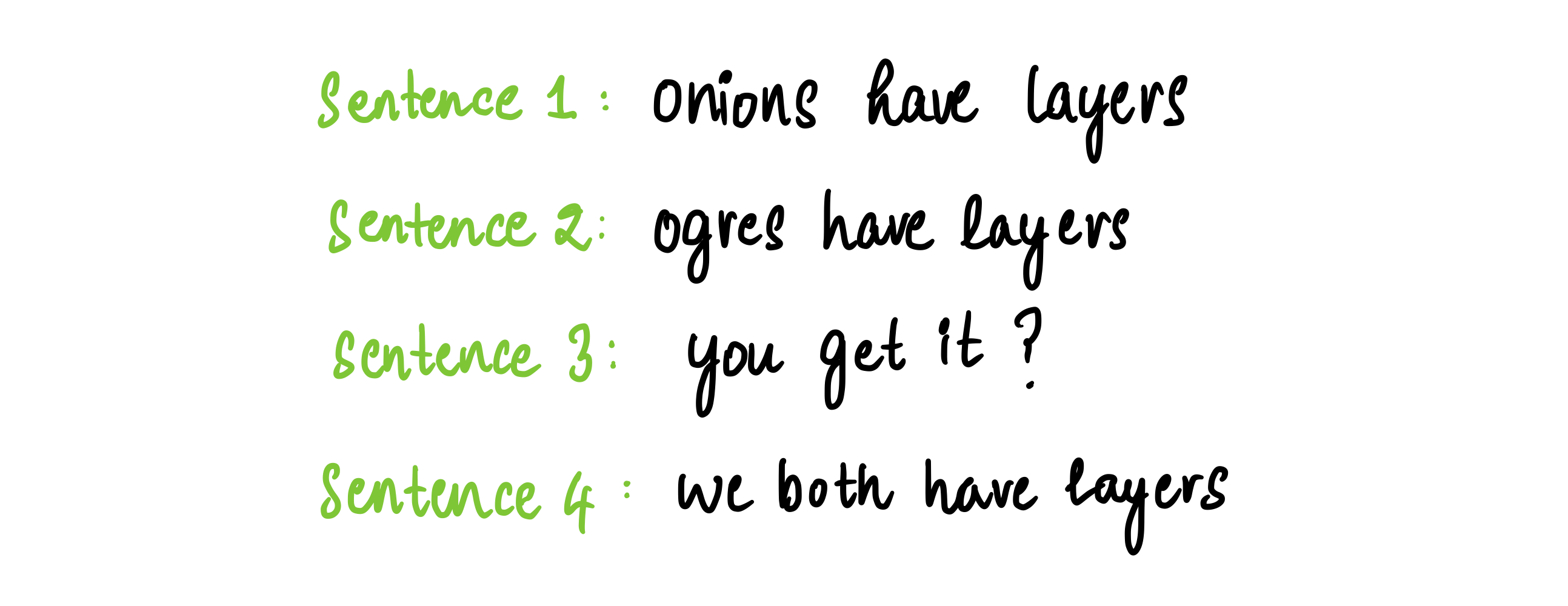
An illustrated guide to text-to-number translation, with code
Originally appeared here:
NLP Illustrated, Part 1: Text Encoding
Go Here to Read this Fast! NLP Illustrated, Part 1: Text Encoding



Business value through Data and Artificial Intelligence. Everybody talks about it, yet most companies are struggling to monetize their data. I claim that in most cases, this is due to a lack of effective business strategy. This article shows what strategic groundwork is necessary to activate your company’s data assets.
This is part two of a series of articles, in which I demystify data strategy — an essential component for any organization striving to become data-driven in order to stay competitive in today’s digital world.
I am Jens, a business minded data expert with nearly 2 decades of practical experience in implementing data & AI use cases. I advise leaders from various industries on designing strategies & cultivating a data culture to leverage data, analytics & AI.
1. What is Going Wrong With Data?
1.1 Symptoms of Dysfunctional Data Value Creation
1.2 The Root Cause
1.3 How Big is The Problem?
2. Playing To Win
2.1 Its Origins
2.2 Strategy Is About Making Choices
2.3 The Strategy Choice Cascade
2.4 The Cheat Sheet
2.5 Making Integrated Choices
2.6 Chartering Choices
2.7 Bringing Strategy to Life
3. Data Business Needs
3.1 No Clear Data Needs
3.2 Data as Operational Duty
3.3 Data as Strategic Differentiator
3.4 Data as Business
3.5 Why Does it Matter to Know Your Data Business Needs?
4 When Is a Dedicated Data or AI Strategy Needed?
4.1 The Data Strategy Mystery
4.2 Strategy For a Data or AI Functions
4.3 A Plan to Build Data Capabilities
5 Putting It All Together
5.1 A Process to Lay The Strategic Groundwork for Data
5.2 An Example for Chartering Data-Related Choices
6 Conclusion
References
Organizations big or small, public or private, all strive to become data-driven. Being data-driven means that data, which is created by internal operational processes is ‘recycled’ to support human decision making, to automate decisions and to enable digital business models.
In general, leveraging data can lead to:
For more details on the motivation and context of data-driven organizations, see part 1 of this series of articles [1].
The data consulting industry, numerous data experts (including myself) and technology vendors never tire of repeating the compelling reasons, why organizational leaders should invest in their data capabilities including skills, competencies, methodology, culture and — of course — corresponding IT tools and platforms. A quote translated from [2] brings it to the point:
“Consistent value creation with data is already a decisive competitive advantage for companies today, and in the near future it will even be essential for survival.” [2]
The topic has gained attention in recent years due to the quite impressive technical advances and the resulting medial hype around Generative Artificial Intelligence (GenAI), which has arrived in the mainstream media and — at least for me personally —is even part of many private conversations with family and friends.
Despite the current GenAI hype, the theory and the practice of data value creation are anything but new. It has appeared under different names in the past, such as Analytics, Business Intelligence, Statistical Modeling, Data Science, Machine Learning, Big Data and is now mainly called Artificial Intelligence. All these terms describe more or less different techniques to extract insights out of data, which — when done correctly — allows to improve business demonstrably.
Being a mathematician, I spent many years in the role of a Data Scientist applying statistical methods to detect patterns, which could be used by businesses to increase understanding of consumers, markets or competition, which in turn could be leveraged to increase revenue or to reduce costs or risks. There exist many practice-proven and well-understood use cases for data value creation in every industry and every point of the value chain.
Whilst there are clear applications and benefits of ‘recycling’ data to create additional business value and even to transform existing business models, I also observe a very different picture of business reality:
Many organizations just struggle to effectively and efficiently leverage data to create business benefits.
What is going wrong with data in organizations?
The list of problems organizations have regarding data can be long [13] and each organization is certainly different. However, it often comes down to some typical suspects:
These are are symptoms many organizations know all too well. But what is the root cause of all this pain?
There was and there still is the persistent misconception that data value creation is a technical challenge. If we just introduce the right platform and provide the required training, the organization will be able to effectively and efficiently use data to create business value. But this is a fallacy.
IT platforms, tools and algorithmic libraries have been around for a while, have matured, are ready to use and continue to improve. And whilst the technical extraction and preparation of data should be done ‘properly’, in order to achieve high quality data as well as scalable and flexible data models, there exist proven frameworks and best-practices to achieve exactly that.
To choose and implement IT platforms, tools, best practices and algorithmic libraries for data is a complicated, but not complex problem, which is actually solved.
Organizations either have the expertise to select and implement technology in-house or can easily get solid external expert consulting on the matter.
I claim, that the root cause for dysfunctional data value creation is a lack of coherent business strategy:
The lack of business strategy is the root cause why so many organizations fail with data, analytics and AI.
If the business strategy is not explicitly defined, organizations struggle to build and maintain the data capabilities they require to effectively and efficiently discover, innovate, build and maintain data-driven solutions.
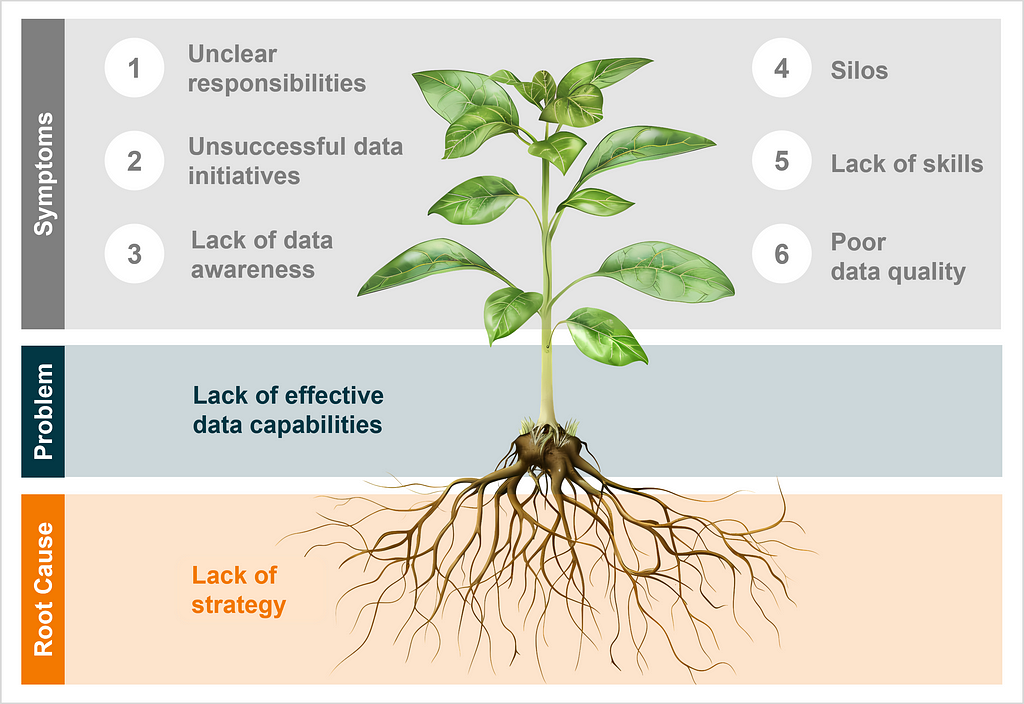
For example, one core data capability required to be successful with data value generation is (data) culture [3, 4], which ensures that employees:
However, in order to create an effective data culture, you need to know the direction your target culture should head to. You have to know the data business needs, which guide you in which direction you need to develop your target data culture. And these data business needs are provided by strategy.
Without a clear business strategy, it’s hard to agree on what the business needs for data, analytics, and AI are in the organization. The role of data value creation is then unclear. However, in order to build tailored and sustainable data capabilities, you simply need to understand if the main purpose of data in your organization is, for example, to provide a set of reports to the CFO or if data is a means to drive your competitive advantage, say through digital products and services.
By making implicit choices explicit through thoughtful strategy design, you build a form of communication to create a consensus about your data business needs.
Getting your data & AI capabilities right is surely not the sole benefit of crafting a solid strategy for your organization. It is rather a side effect. This should be self-evident, but for the sake of completeness, the benefits of having an explicitly and well-designed business strategy are for example:
When I start an engagement with a new client to help with data-related problems, one of the first information requests I usually carry out is to ask for relevant strategy documentation, most importantly the (corporate) business strategy. I often receive vague responses like:
In cases when a strategy documentation is provided, it often turns out to be a loose list of initiatives, which all sound good, but overall does not meet common strategy standards [5a].
While I am not aware of representative statistics on the matter, and the presence of a good business strategy might certainly depend on the size of the organization and potentially other factors, such as industry, my personal impression of the German speaking market, the playing field in which I am most active, is that many companies are lacking a solid, explicit, well designed strategy.
Very few organizations pursue a solid, explicit business strategy, from which the required data, analytics and AI capabilities can be deduced.
In my experience, things look particularly challenging with small and mid-sized enterprises, the “Mittelstand”, which is the backbone of the German economy for which around 56% of employees work [6].
With this article, I aim to address the root cause of organizational data failures by clarifying what strategic work is necessary to leverage data as an asset.
To get started, let’s have a close look at what strategy actually is.
Playing to Win is a strategy framework originated by Roger Martin [7], named world’s #1 management thinker in 2017, trusted advisor to CEOs of companies around the world, former Monitor consultant and former Professor of the Rotman School of Management.
The framework was developed and continuously refined in the 1980s and 1990s [5b] and culminated in a joint book [8] by Roger Martin and A. G. Lafley, who is a former CEO of P&G. The book was published in 2013.
The framework became the standard strategy methodology at P&G and has successfully been applied in many industries since. In addition, the Playing to Win framework has constantly been detailed by Roger Martin through a series of Strategy Practitioner Insights [5, 5c].
Whilst there might be other well-suited strategy frameworks out there, I choose the Playing to Win approach above others, since it is widely known and applied and comes with an entire ecosystem of processes, templates, resources and trainings that can be leveraged for designing any kind of strategy.
In the Playing to Win framework, strategy is defined as follows [8]:
“Strategy is an integrated set of choices that uniquely positions a firm in its industry so as to create sustainable advantage and superior value relative to the competition.”
So strategy is about making (often tough) choices that give your firm a competitive edge. There is, however, no bullet-proof certainty that these choices will turn out to be the right ones. The result is always a strategic bet. The strategy design process aims to shorten your odds, i.e. to maximize the probability of success, given the information available.
Note that this definition of strategy is quite different to a plan, which is often misunderstood as strategy [9, 5d].
“Planning is the act of laying out projects with timelines, deliverables, budgets, and responsibilities.” [5d]
However, a strategy and a plan are not exclusive. Crafting plans is a natural part of the strategy design process, in order to build the capabilities required to bring the strategy to life (cf. Section 2.7 below).
There is another definition of strategy, which I particularly like, namely: “Strategy is the logic that determines what you choose to do and not do in service of a particular goal” [10].
Consequently, every organization has a strategy, whether it’s written down or not. Such implicit strategy can be deduced from the actions a company takes. The problem with such implicit strategies is, that there might not be a consensus in the organization what this implicit strategy is and that actions may be ineffective.
Within the Playing to Win framework, there are five key choices every strategy designer must make. These choices are structured in the so called Strategy Choice Cascade, which is one of the core tools of the framework.
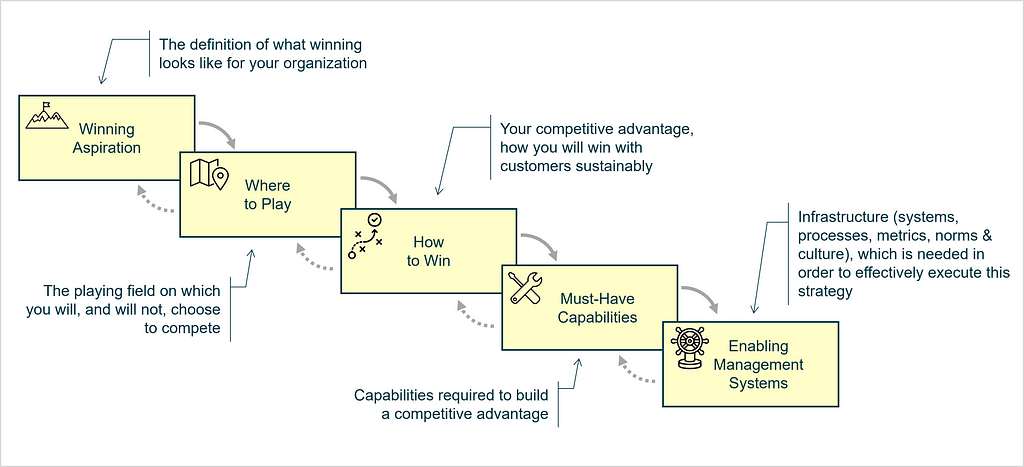
The actual heart of the strategy is made of the coherent choices made in boxes two and three: Where to Play & How to Win.
How the cascade is applied is best illustrated using a real-world example, which is taken from [9] and describes choices for the corporate strategy of Southwest Airlines.
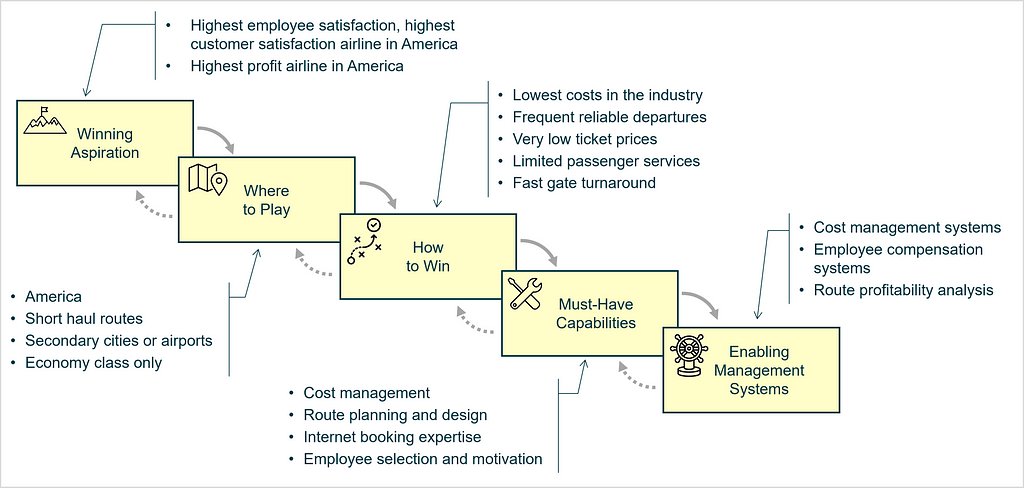
The cascade is not filled out just once; it is revisited and utilized repeatedly for various use cases throughout the strategy design process:
When I work with the cascade, my Playing to Win Cheat Sheet assists me, which contains some further information on the individual boxes together with the main sources for the framework.
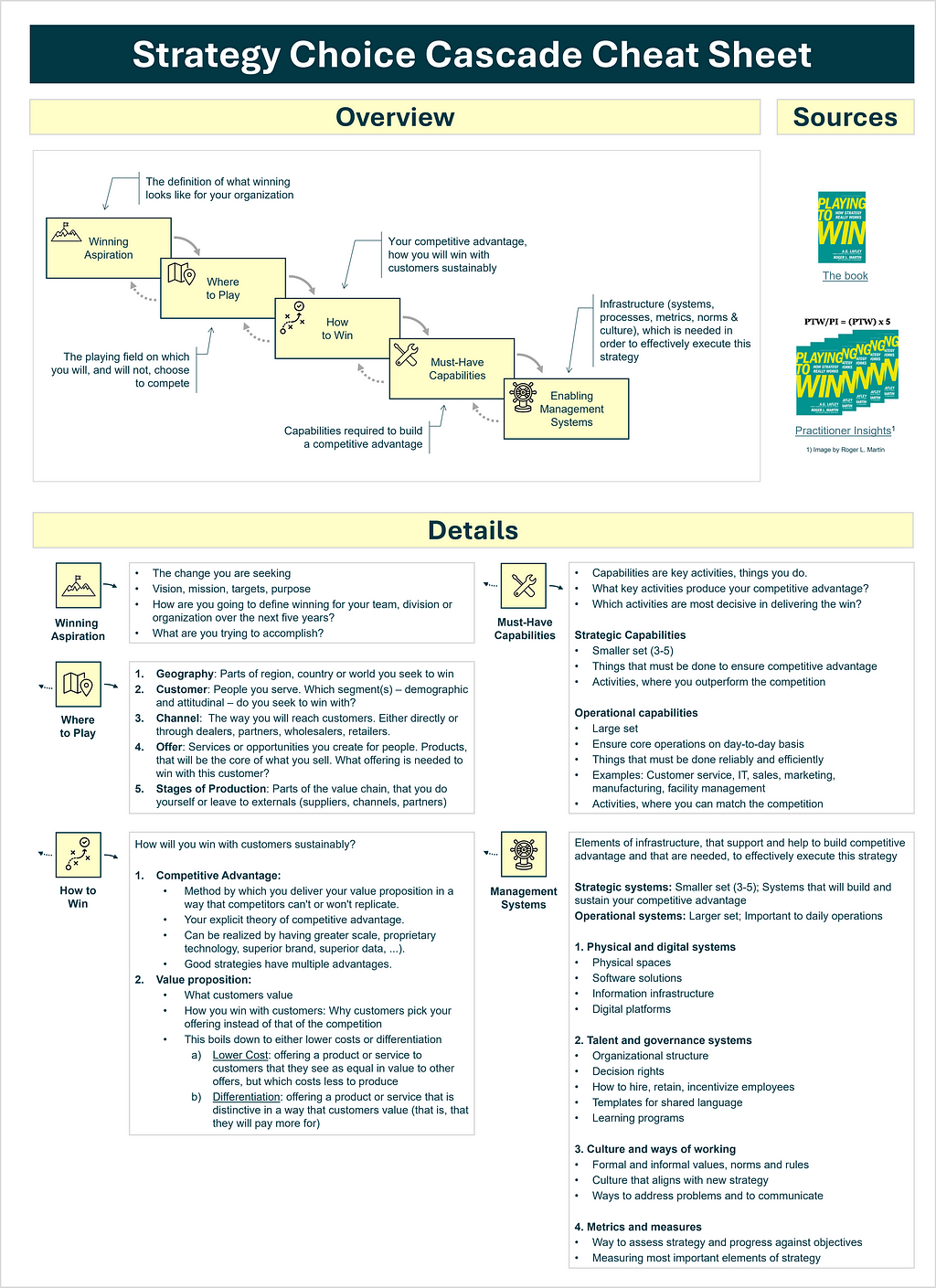
When working on the strategy cascade, the boxes should never be filled individually [5g], but need to be considered together as the choices of a real strategy should fit together nicely and reinforce each other.
This applies particularly for the Where to Play and How to Win, which are inseparable pairs and always need to be considered together [5h].
But also when considering the Must-Have Capabilities and Management Systems, you need to keep your Where to Play and How to Win in mind. Capabilities and systems are a kind of a reality check: if you cannot build the capabilities and systems required to bring your strategy alive, you need to think of a different way to win and sometimes even of a different playing field.
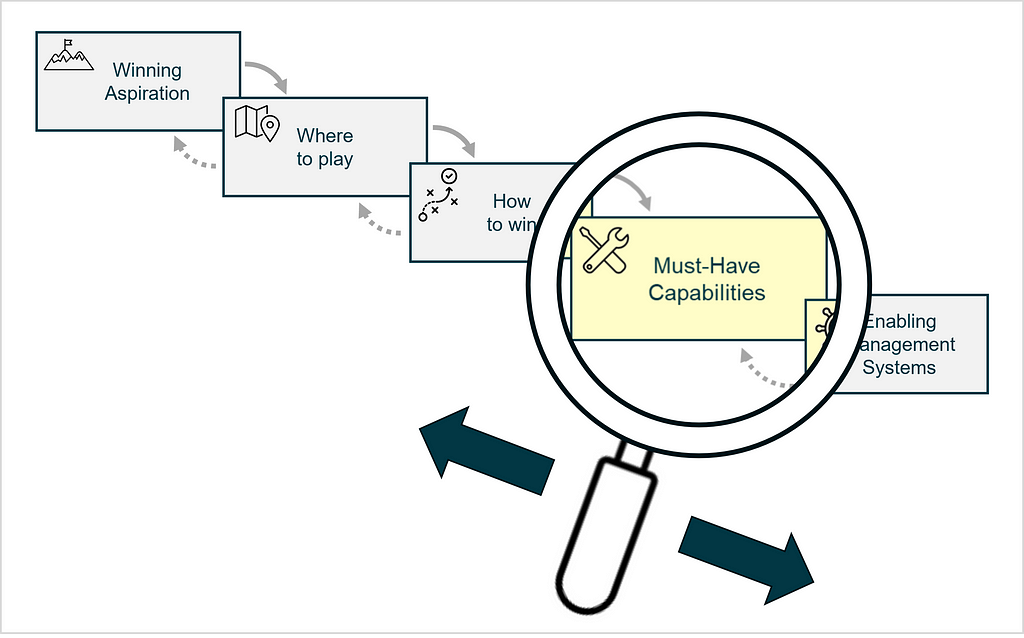
From this it should be clear, that the exercise of filling the strategy choice cascade can be a quite iterative process moving back and forth until you arrive at a set of choices with a convincing theory of winning for the chosen playing field enabling the winning aspiration, which can realistically be achieved with the required capabilities, which are built & maintained with the needed management systems.
Strategic choices occur throughout the organization and not all choices are made at the top (corporate) level.
Choice Chartering [5i] is the structured process of defining, communicating, and delegating strategic choices throughout an organization to ensure aligned and effective decision-making at all levels.
Consequently, in large organizations there exist nested strategies and corresponding choice cascades, e.g. for a country, category, brand, or business unit strategies.
Not only individual business units need to make their own strategic choices and thus formulate nested choice cascades, but also functions [10], such as IT, HR, Finance, Marketing, R&D or Data & AI.
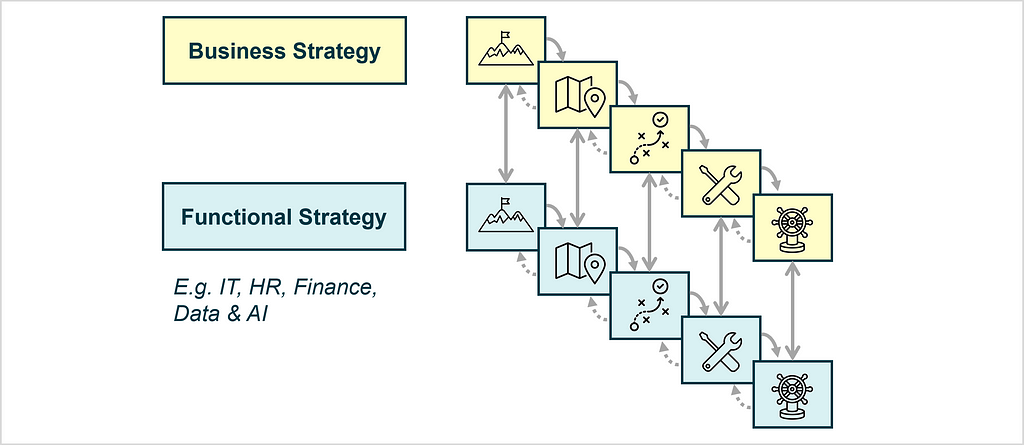
One particularity with functional strategies is, that they can be treated as natural monopolies [5j], where (internal) customers usually have no other choice than using the offering provided from that function.
A good strategy design process does not distinguish between the creation and subsequent execution phase, but builds activation into the strategy process from the very first beginning [11].
The goal of strategy activation is that everyone understands the design choices made and stakeholders are enabled to make their own choices to support the strategy.
Strategy activation includes the creation of stakeholder engagement, to make the strategy tangible and to move from design into action by building the Must-Have Capabilities and corresponding Enabling Management systems.
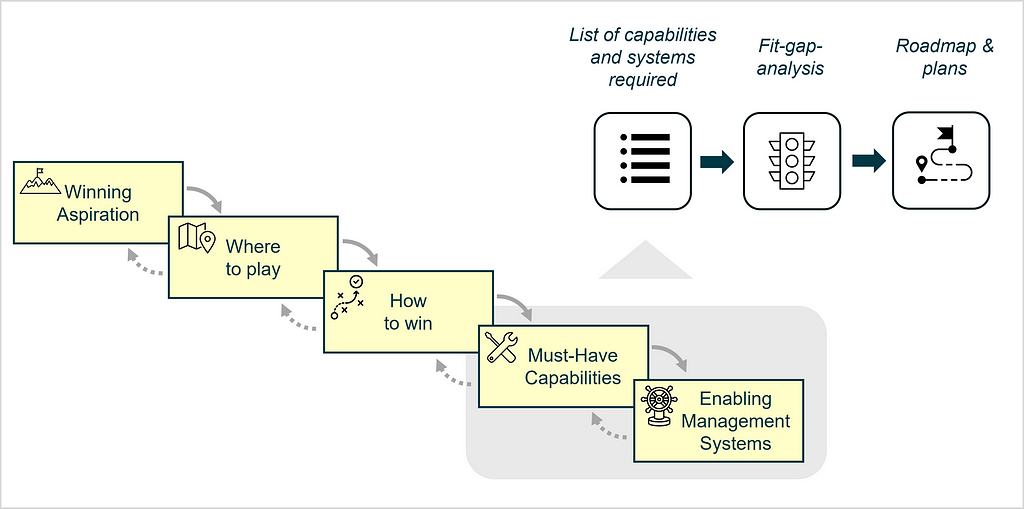
Once the capabilities and systems are defined, they need to be built and maintained. A fit-gap-analysis — often called maturity assessment — for each capability or system then provides the input to create plans for building, buying or borrowing the capabilities and systems needed.
Interestingly, (data) consultancies often offer to start with maturity assessments as a kind of foot-in-the-door offering for clients. From the above mentioned, it should however be clear, that any fit-gap activities only make sense after the groundwork of strategic work has been finalized.
Bringing strategy to life also provides the link to planning, which is often confused with strategy: strategic choices typically require new capabilities to be built, for which actions plans are required, once the status-quo has been evaluated.
Once you have made your business strategy explicit, it should be clear what role data, analytics and AI play for your organization, i.e. what your (corporate) data business needs are.
It is as simple as that:
Business strategy must provide an answer to how relevant data for your organization or business unit will be.
When using the Playing to Win framework, one glance at the choice cascade of your business strategy should clearly indicate the relevance of data for your business.
The data business needs can take one of four different forms.
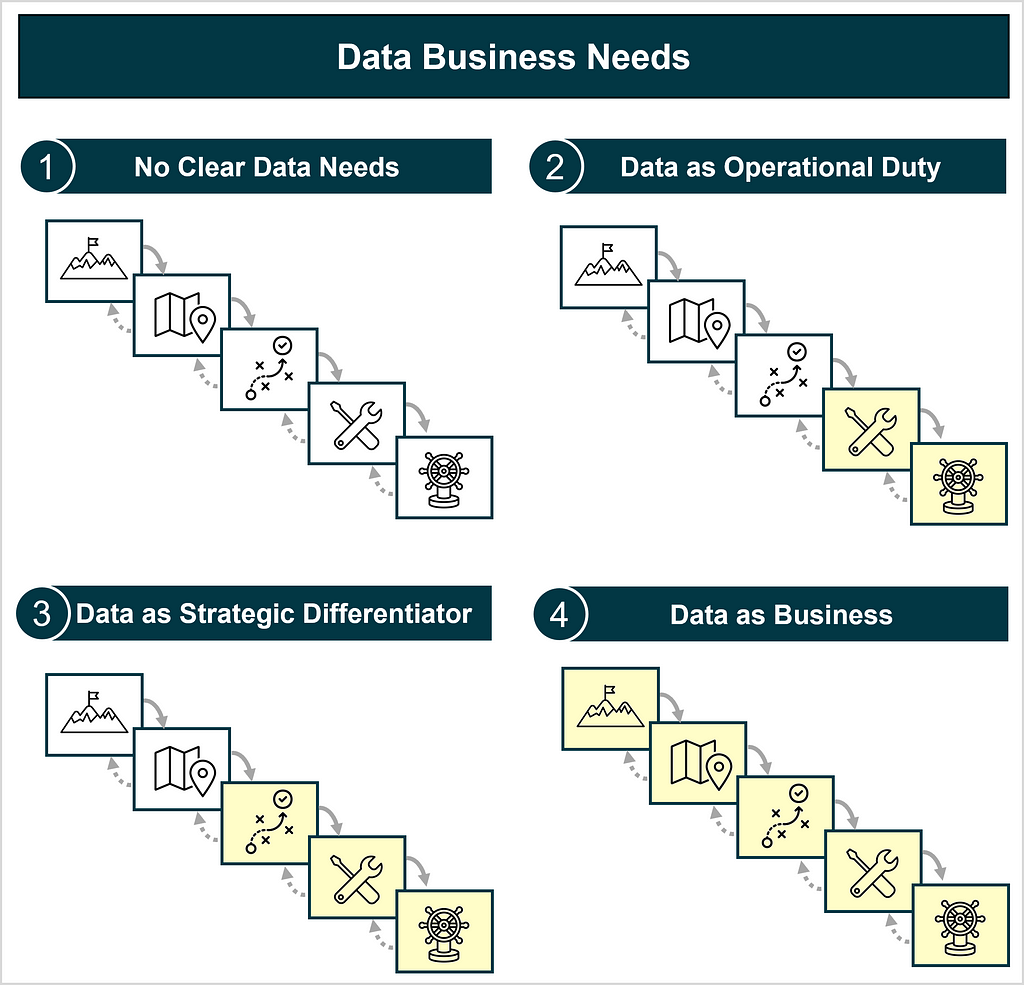
Let’s deep-dive into each of these four scenarios.
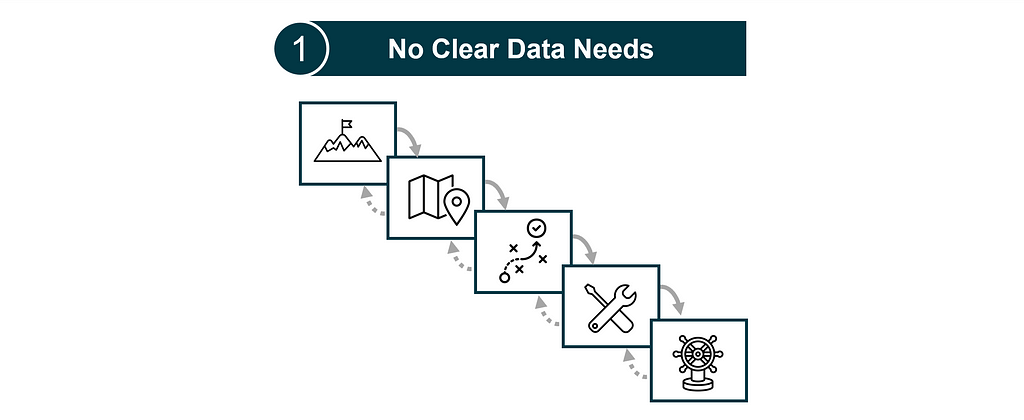
In this scenario, there is no consensus in the organization if data value creation is at all necessary to win. That means, data seems to be irrelevant for any of the five boxes of the strategy choice cascade.
Example
An example might be a small traditional crafts business focused on handmade goods, which relies on artisanal skills, reputation, and customer relationships.
Recommendations
While I believe that data, analytics and AI are not the center of the universe and not every organization depends on it to win, as a potentially biased data professional, I would naturally challenge such a viewpoint by asking:
The organization should gain clarity about potential data use cases and how relevant these are for the business.

In the second scenario, data, analytics and AI are operational, but not strategic capabilities and/or systems, and should therefore be realized as cost-efficient as possible. Relevant data elements can be found within in box four and five of the cascade, namely Must-Have Capabilities and Enabling Management Systems.
Example 1
For the case of Southwest Airlines above, the business need for data, analytics and AI is to manage the complexity of airline operations efficiently and cost effectively.
The company needs to build, run and maintain Enabling Management Systems to ensure operational efficiency [12]:
This means for the Southwest example, the business needs for data, analytics and AI are mainly found in the last box — Enabling Management Systems.
Example 2
A regional utility company uses data, analytics and AI to monitor energy usage, predict maintenance needs, and generate internal reports. Like in Example 1, data helps to achieve operational efficiency and to meet compliance requirements, but does not provide a strategic differentiation.
Hence, data, analytics and AI are capabilities (box 4) or systems (box 5) representing an operational imperative rather than a strategic capability.
Examples for data related enabling management systems could be data reporting systems needed to provide management insights, BI tools or a corresponding data platform.
Recommendations
When building and maintaining data related capabilities and systems of the business strategy for this scenario, cost-efficiency should be a key dimension when determining whether to build, borrow or buy the capabilities and systems needed to win in the specified playing field.
Whilst there is nothing wrong with using data solely for operational efficiency, organizations should regularly assess whether strategic opportunities are being overlooked. Naturally, as a data professional I would challenge this by asking:
Again, organizations should aim for achieving clarity about potential data use cases and how strategically relevant these are for the current business model or if the existing business model could be extended using data, analytics and AI.
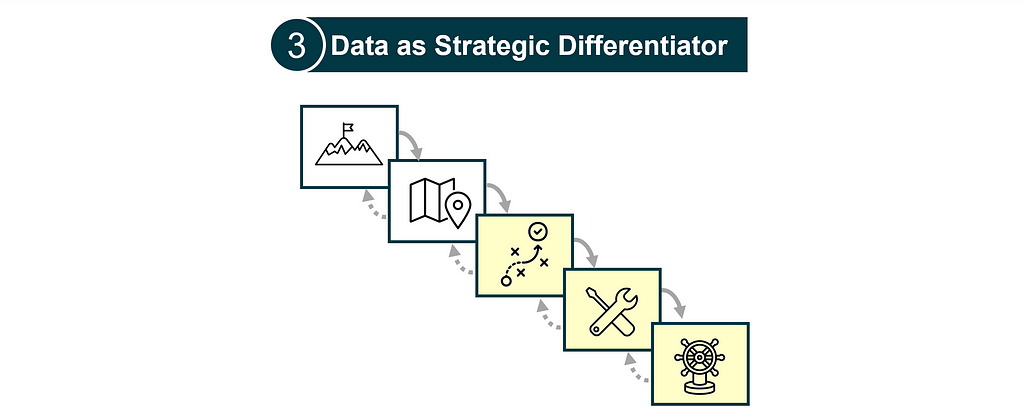
In this scenario, data, analytics, and AI serve as core differentiators, directly influencing how the company wins in the market. They are a key part of realizing the company’s value proposition, helping the firm to create a competitive edge (box 3: How to Win) or are key strategic capabilities (box 4: Must-Have Capabilities) to realize the theory of competitive advantage.
Example
This example, which is borrowed from [5k], is the one of Frito Lay, a salty snack producer (Lays, Doritos, …), which uses a direct-store-delivery system, where the product is directly delivered to convenience stores and placed on the shelf by the delivery driver.
This direct-store-delivery system is labor-intensive and hence expensive, but it differentiates Frito Lay from its competition. Having a large number of well-known products creates a massive cost advantage for Frito Lay’s delivery system (one stop for many products) producing a unique competitive advantage, that cannot be matched by competitors.
Building data and AI solutions, that predict store inventory and generate the optimal product orders for each point-of-sale, helps to reduce costs for the direct-store-delivery system. Hence, data, analytics and AI are strategic capabilities (box 4: Must-Have Capabilities), which directly support the competitive advantage (box 3: How to Win).
Recommendations
Use the business strategy cascade to communicate the strategic importance of data in your organization. Make sure that executives and all relevant stakeholders understand the impact and value of data, analytics and AI for your business. This lays the foundation for necessary data culture and data literacy developments and the organizational changes required to fully build the capabilities needed to win.
Finally, it also helps in discussion regarding funding as well as to set the right priorities.
Critically question whether it makes sense to outsource any of the data capabilities, as they are of strategic importance for the organization.
Push your thinking, consider whether there are additional opportunities for data monetization [16], potentially leading to ‘Data as Business’.
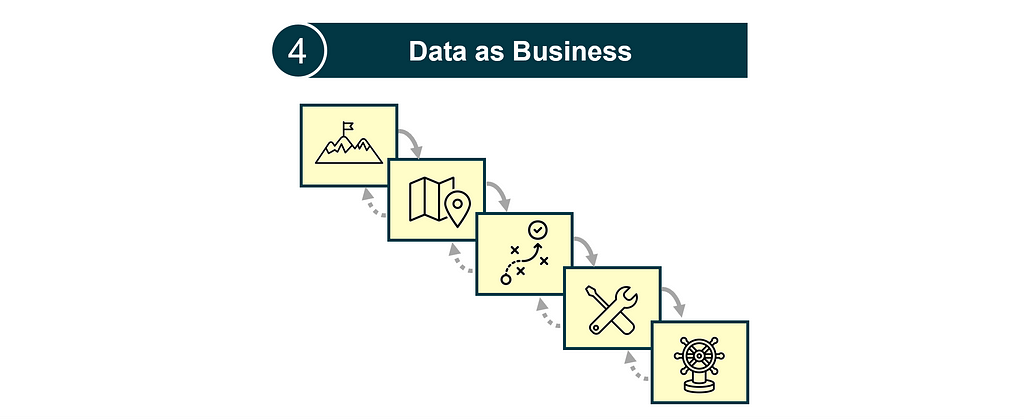
This is the scenario, which most people get excited about: data extends or even radically changes the current business model and organizations enter the digital economy.
In this case, digital data-driven products or services are part of the company’s offering (box 2: Where to Play) and can even be part of the vision (box 1: Winning Aspiration).
Example
This example is also borrowed from [5k] and is about Westlaw, a digital provider of legal search services. One of Westlaw’s strategic assets is a database of notes about court cases dating back to 1975, which allows lawyers to browse historical cases for their legal matters at hand.
The data is part of the firm’s offer (box 2: Where to Play) and its uniqueness in the market secures its competitive advantage (box 3: How to Win).
Recommendations
As data is clearly a company asset that secures a competitive advantage, make sure the data is treated accordingly. For example, it needs caring, nurturing, protection and quality assurance.
Hence data governance (box 4: Must-Have Capabilities) and corresponding systems (box 5: Enabling Management Systems) are an imperative.
Each organization is different and has unique data business needs.
Your organization needs to be aware what role data, analytics and AI plays in the business strategy, in order to know how much resources to spend for creating and maintaining the data-related capabilities and systems.
Many executives still struggle with the hype around data and AI leading to skepticism, uncertainty or to thoughtless investments into it.
Consequently, a solid business strategy and a thorough understanding of the data business needs provide guidance and helps to communicate the importance and role of data in your organization.
Therefore, I claim:
The first step to become data-driven is solid business strategy design.
If you already think there is confusion around the term strategy, let me tell you it is even worse with the term data strategy. Nearly each article or book I read defines it somewhat differently — if it defines it at all. This gave me frequent headaches when I started to deep-dive into the topic.
In most cases the term ‘data strategy’ is used to refer to a plan for building data-related capabilities within an organization.
It is referred to as a plan for building analytics IT platforms, to roll-out new BI-tools, to build data governance, to increase data literacy, to develop data culture or to build an operating model for data management, analytics and AI.
In my opinion, the term data strategy should only be used to describe the strategy of a function, which provides data services to foremost internal, but sometimes also external data customers.
In many cases organizations will need a data related function, delivering services such as:
If an organization has or will have a function for data management, analytics or AI, which provides services to (internal) data customers, it simply requires a strategy as outlined in Section 2.6 above.
How the strategy choice cascade is applied to design such a data strategy, was topic of part 1 of this series [1].
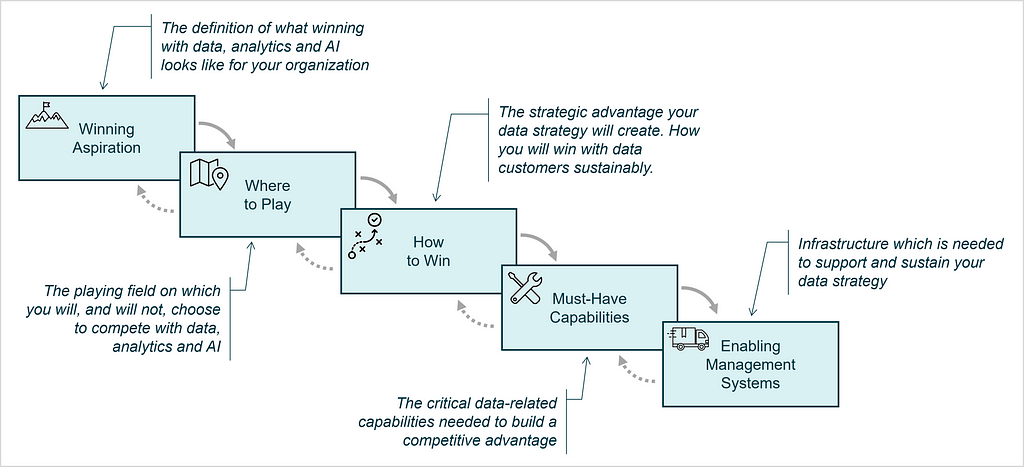
A clear strategy allows the function to gain clarity, where to play and how to win with its data customers. It also guides and aligns its actions, to effectively allocate resources and to enhance the value provided to the organization.
If your data function does not have an explicit strategy, it is likely to default to a damaging implicit strategy, which is either the ‘servile strategy’ (trying to satisfy all possible business demands) or the ‘imperial strategy’ (doing data, analytics or AI just for the sake of it) [10].
Depending on the nature and focus of the services and products provided in this function, you may call it data strategy, analytics strategy, BI strategy or AI strategy.
The data strategy of the function usually contains capabilities and systems that span across or exist in multiple parts of the organization, such as a corporate analytics data platform. In strategy language, such capabilities and systems are referred to as a reinforcing rods [8, 5l].
The plan to build data related capabilities and systems is the topic most companies are enthusiastic when it comes to data, analytics or AI.
To create such a plan can be a challenging endeavor, so it is well invested time. All I am saying is that you need to make sure, that the strategic groundwork has been done beforehand, so you know what kind of capabilities and systems you actually need to win. The nature of the plan and the requirements for many design choices depend on that strategic groundwork.
The scope of such ‘data plans’ can vary widely depending on the organization’s data business needs: from building a reporting system and corresponding data landscape exclusively for controlling purposes to enabling many business units and functions to extensively leverage potentials from data use cases along the entire value chain.
The latter often goes together with a company-wide transformation program, and the plans for building data capabilities can be part of an overarching data-driven business transformation roadmap, led by a dedicated leader for data, analytics or AI [14, 15] – sometimes called Chief Data Officer.
A plan to build data or AI capabilities and systems should come last, as the result of a fit-gap-analysis, in which the target state is provided by the preceding strategic choices.
Therefore, organizations require clarity about their data business needs, i.e. what role data, analytics and AI will play in their future business. The bottom line: You need to start with the strategic groundwork.
A process to approach the design of effective data and AI capabilities, could look as follows:

1. (Re-) Design your business strategy
2. Charter relevant choices
3. Assess & plan capabilities and systems
4. Build capabilities and systems
By laying the strategic foundation, you will address the root cause of dysfunctional data value creation in your organization.
Laying the strategic foundation ensures that executives and employees will understand the role of data within your organization. This, in turn, will help to build effective and sustainable data capabilities and to provide guidelines on the necessary resources to invest in developing and maintaining these capabilities.
For step 1, we already saw examples in Section 3 if this article. How might the choice chartering within step 2 look like?
Let’s apply step two of the process to the above example of Frito Lay, where the store inventory forecasting supports the competitive advantage of the direct-store-delivery system.
This use case for store inventory prediction for the sales department may be one of many AI use cases for Frito Lay, so that an AI capability is required in many parts of the organization. Let’s say Frito Lay therefore decides to build a central AI capability leading to a dedicated AI function.
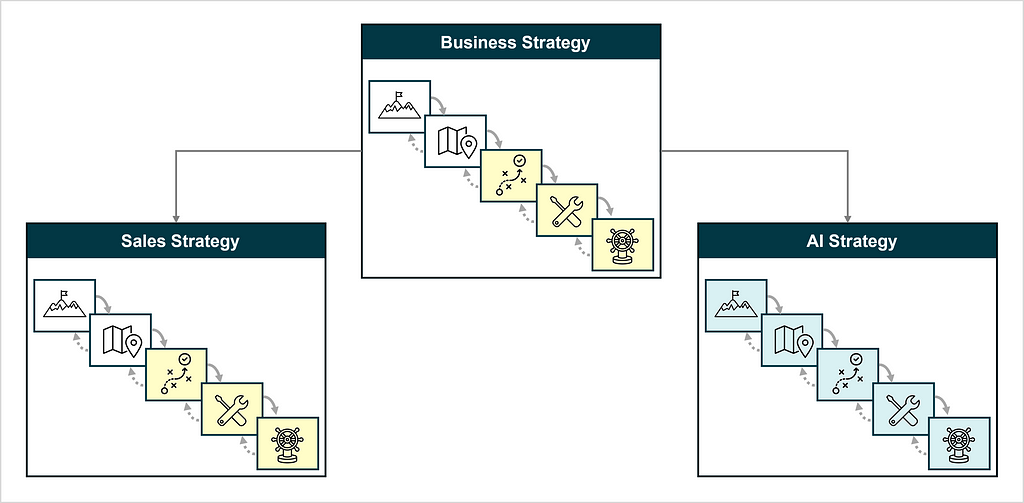
The AI function leader is then tasked with designing an AI strategy that supports the corporate strategy and directly contributes to Frito Lay’s How to Win. One Where To Play in the AI strategy would be to provide forecasting solutions for the sales department.
To ensure the AI forecasting solution has an impact, it would also be necessary to charter data-related choices to the sales leader, such that sales commits to use the AI-driven insights within its planning process. This means that ‘AI-driven sales planning’ becomes a Must-Have Capability of the sales strategy.
The relevance of good business strategy for successful data value creation appears to be underestimated and undervalued. Companies must have a well-defined, explicit business strategy, from which any data, analytics and AI demands are apparent. This strategic foundation is the starting point for chartering data-related choices, whether in dedicated data management, analytics, or AI functions, and for building the necessary capabilities across business units.
For your organization to become data-driven, ensure you have a solid strategic foundation. Otherwise, you will likely run into troubles and will experience the symptoms of dysfunctional data value creation, which we all know too well.
Looking ahead, the competitive landscape is evolving rapidly. The most successful organizations of the future will be those that recognize data as a strategic asset, not just a byproduct of their operations. As AI technologies mature and integrate further into business processes, companies with a coherent strategy will be poised to capitalize on these advancements, creating new revenue streams, driving innovation, and maintaining a sustainable edge over their competition. In the coming years, we will see a growing divide between companies that have laid the strategic groundwork for data and AI and those that continue with business as usual. The former will thrive, while the latter may struggle to survive in an increasingly data-driven world.
The time to act is now: prioritize your strategy (re-) design, align on your data business needs, and build the capabilities needed to win with data. Only then can you truly harness the transformative power of data, analytics and AI for long-term success.
[1] Jens Linden, The Data Strategy Choice Cascade (2024), Medium article published in Towards Data Science
[2] Sebastian Wernicke, Data Inspired (2024), book in German language published by Vahlen
[3] Carsten Bange, Data Culture: Definition, Herausforderungen & Maßnahmen (2022), article
[4] Jens Linden, Datenkultur — Was & Warum? (2024), LinkedIn post
[5] Roger Martin, Playing to Win/ Practitioner Insights (2024), website with list of articles
[5a] Roger Martin, From Laudable List to How to Really Win (2020), Medium article of the ‘Playing to Win Practitioner Insights’ series
[5b] Roger Martin, The Origins of Playing To Win (2023), Medium article of the ‘Playing to Win Practitioner Insights’ series
[5c] Roger Martin, (Playing to Win) x 5 (2024), Medium article of the ‘Playing to Win Practitioner Insights’ series
[5d] Roger Martin, Strategy vs. Planning: Complements not Substitutes (2024), Medium article of the ‘Playing to Win Practitioner Insights’ series
[5e] Roger Martin, The Best Strategy Icebreaker (2024), Medium article of the ‘Playing to Win Practitioner Insights’ series
[5f] Roger Martin, The Strategic Choice Structuring Process, Medium article of the ‘Playing to Win Practitioner Insights’ series
[5g] Roger Martin, Overcoming the Integrative Strategy Challenge (2024), Medium article of the ‘Playing to Win Practitioner Insights’ series
[5h] Roger Martin, On the Inseparability of Where-to-Play and How-to-Win (2020), Medium article of the ‘Playing to Win Practitioner Insights’ series
[5i] Roger Martin, Strategic Choice Chartering (2024), Medium article of the ‘Playing to Win Practitioner Insights’ series
[5j] Roger Martin, Strategy for Natural Monopolies (2024), Medium article of the ‘Playing to Win Practitioner Insights’ series
[5k] Roger Martin, Distinguishing How-to-Win from Capabilities in Your Strategy Choice (2021), Medium article of the ‘Playing to Win Practitioner Insights’ series
[5l] Roger Martin, Corporate vs. Business Unit Strategy (2022), Medium article of the ‘Playing to Win Practitioner Insights’ series
[6] statista, Mittelstand als Rückgrat der Wirtschaft (2024), website in German language
[7] Roger Martin’s website (2024)
[8] A. G. Lafley and Roger L. Martin, Playing to Win (2013), book published by Harvard Business Review Press
[9] Roger Martin, A Plan Is Not a Strategy (2022), video
[10] Roger Martin, Jennifer Riel, The One Thing You Need to Know About Managing Functions (2019), article published in Harvard Business Review
[11] IDEO U, Activating Strategy (2024), website
[12] Tableau, Southwest Airlines maintains on-time flights and optimizes fleet performance with Tableau (2024), website
[13] Jens Linden, Data First Aid Kit (2022), LinkedIn Post
[14] Caroline Carruthers and Peter Jackson, The Chief Data Officer’s Playbook 2nd edition (2020), book published by Facet Publishing
[15] Caroline Carruthers and Peter Jackson, Data-Driven Business Transformation (2019), book published by Wiley
[16] Jens Linden, Datenmonetarisierung — Das ‘Where to Play’ für Datenstrategien (2024), LinkedIn Post
Unless otherwise noted, all images are by the author.
The Root Cause of Why Organizations Fail With Data & AI was originally published in Towards Data Science on Medium, where people are continuing the conversation by highlighting and responding to this story.